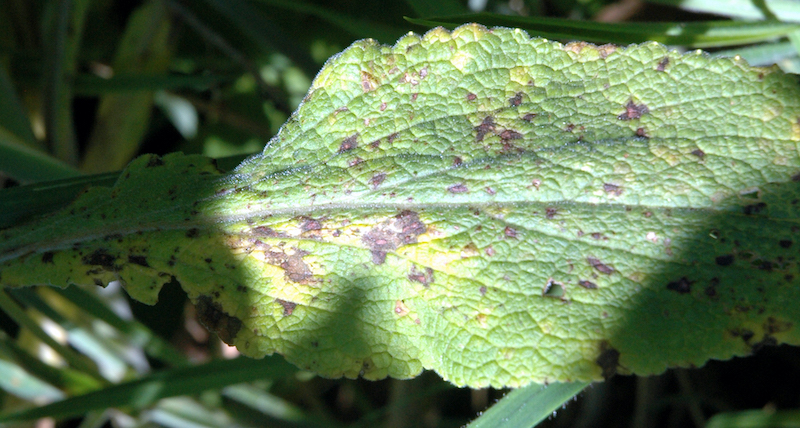Foxgloves are a mostly trouble-free group of ornamental plants. They are able to grow in a wide range of USDA growing zones and are known to reliably self-seed and carry on for years in the garden. Diseases that are most common for Foxglove are Leaf Spot and Downy Mildew. Diagnosing and treating these diseases quickly will ensure that your Foxgloves survive to reseed and reappear for another growing season.
Leaf Spot
Leaf Spot attacks the soft tissues of plants and can cause dieback of foliage if left untreated. The most common cause on Foxglove is the fungus Ramularia cynarae, Artichoke Leaf Spot. This fungal disease is active in warm humid weather and can cause damage on both the leaves and in the developing flower buds.
Identifying Leaf Spot
Small, brown spots appear on leaves and gradually overtake all of the leaf tissue. Infected leaves may fall off. Flower buds may also develop brown spots. White mold spores may form on infected foliage left on the plant or ground.

Photo by Jay W. Pscheidt, Oregon State University 2016
Treating Leaf Spot
Remove any affected plant material immediately, and avoid overhead watering of plants as much as possible to prevent further spread of the fungal spores. Good garden hygiene at the end of the growing season will prevent the fungus from overwintering in the garden. Throw away or destroy any infected plant material. Home composting is not recommended for infected plant waste, although municipal green waste or composting is able to kill off pathogens effectively. Look for Foxglove varieties that are resistant to Leaf Spot and Blights.
Downy Mildew
Downy Mildew is most active during periods of cool temperatures and high humidity. The fungus that causes Downy Mildew on Foxglove is transmitted by water, although the spores can be carried by wind between plants. Downy Mildew is sometimes confused with powdery Mildew, even though they appear under different conditions. Unlike Downy Mildew, Powdery Mildew favors cool, dry weather. Powdery Mildew is also easily recognized by the white powdery spores that grow on the topside of leaves.
Identifying Downy Mildew
Dark spots form on the top sides of the affected leaves. If left untreated, the fungus will set spores on the undersides of the leaves, resulting in a white or grayish fuzzy appearance. Wind can carry the spores to infect other plants. If temperatures rise above 70 degrees F, the fungus will die off, sometimes without leaving the downy spores.

Photo by Jenny Glass, modified, WSU Plant & Insect Diagnostic Laboratories 2011
Treating Downy Mildew
Remove any affected leaves promptly. Avoid overhead watering, especially during periods of cool weather. Ensure that plants are spaced far enough apart for good air circulation. Thin seedlings early to avoid overcrowding.
Foxglove Disease Chart
|
Disease |
Identifying |
Treating |
|
Leaf Spot |
Brown spots on foliage or flower buds |
Remove affected foliage, avoid overhead watering |
|
Downy Mildew |
White or gray fluffy spores on the underside of leaves, brown or dark spots on the tops of leaves. |
Provide good air circulation and remove affected stems and leaves immediately. |
Sources:
"Downy Mildew on Ornamentals." University of Connecticut, Integrated Pest Management Program. ipm-cahnr.media.uconn.edu
"Foxglove (Digitalis)." Connecticut State - The Connecticut Agricultural Experiment Station. portal.ct.gov
 |
Author Robbin Small - Published 6-24-2023 |
